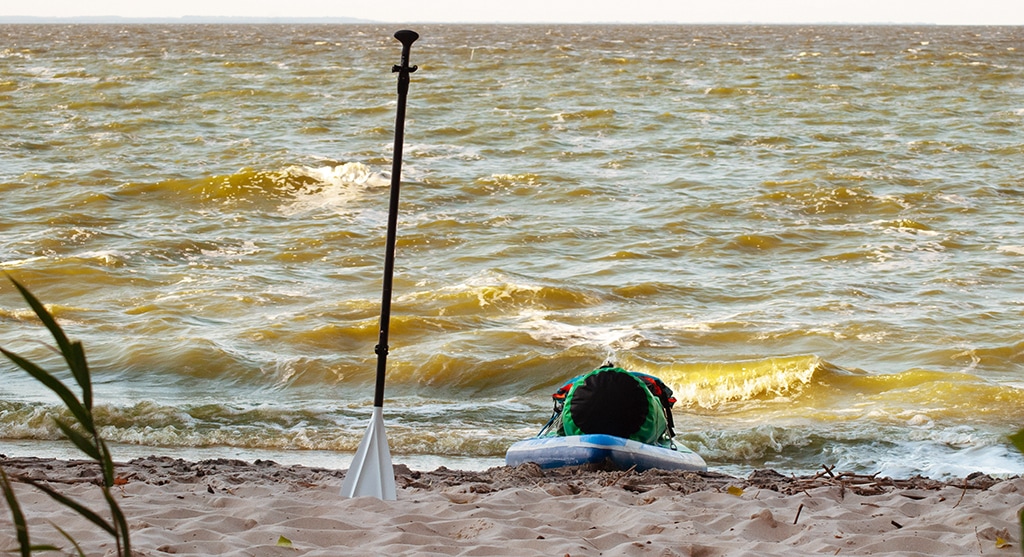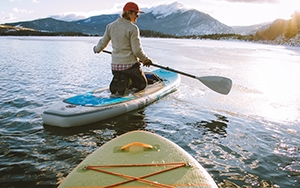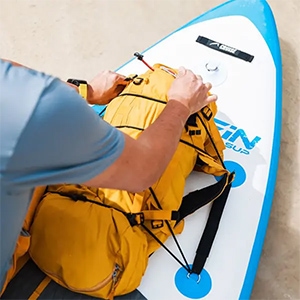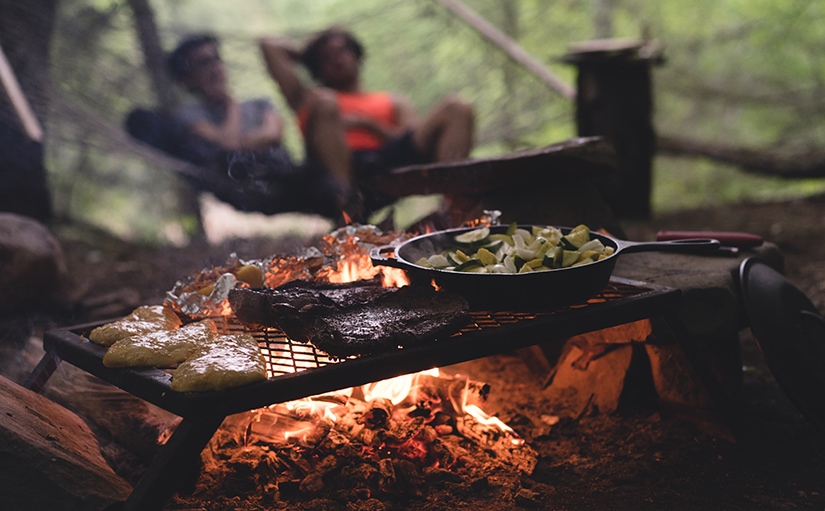The day-to-day routine of life can be exhausting. There is always so much to do and some days it feels like you’re going through the motions. We could all use a break every once in a while.
SUP camping is the perfect way to get away from your busy schedule. It provides an opportunity for your family to look up from their screens and reconnect with nature.
You can create beautiful memories as you enjoy a simple, stress-free life for a short while, and also keep active while you do it! And don’t forget that stand up paddle boarding is a full-body workout. So there’s that too.
The best part? Paddle board camping is easy to plan and cheap—cheaper than your average vacation.
So let’s talk about everything you need to know about this amazing outdoor activity.
Planning Your SUP Camping Trip
You know the old saying- if you fail to plan, then you plan to fail. It’s true, poor preparation is a recipe for disaster, especially when going to a place you have never been before.
A plan acts as a guide, so you don’t rely on guesswork. It also ensures your safety. Let’s take a look at what you need to consider when planning a SUP camping trip
How to Pick Your Camping Destination
The first step of planning is choosing your destination. Where do you want to go SUP camping?
When using a paddle board, your options are unlimited. You can access breathtaking locations that are not accessible by cars or bigger vessels. But don’t get ahead of yourself, more so if it’s your first time.
Consider your skill level, time, distance, and weather.
For instance, if you’re a SUP beginner, you don’t want to be paddling for over five hours. You will get worn out and you might not even get there on time. Plus, if you get there worn out, then you won’t have the energy you need to make camp, get settled, or do any of the things that should make SUP camping enjoyable.
Therefore it would be wise to have a short paddling distance.
Always consider the water and weather conditions as well. Things like the wind and current can greatly affect your trip. Check the weather forecast while planning and again before you begin the trip.
Research your destination and the best route to get there.
What Type of Paddle Board Is Best for SUP Camping?
So now that you have a camping destination, let’s talk about how you are going to get there. You need a stand up paddle board.
It is important that you get the right SUP for your camping trip if you want to have a good time. You should consider your skill level, paddling distance, attachment points, and duration of the trip. You also have to decide whether to get an inflatable or solid board.
Most touring paddle boards would be great for camping.
Skill level: if you are a beginner paddler, you will want a SUP that is wide for more stability. But know that the wider a board is, the slower it is likely to be on the water.
Paddling distance: long-distance paddling requires a fast paddle board if you want to get to your destination on time. Longer and narrower paddle boards glide faster. So you should go for one that is at least 12 feet long.
Attachment points: you will have to carry all your camping gear on your board. You’ll need bungee storage at the front and rear of the SUP.
Extra D-rings will allow you to attach a kayak seat and other stuff. It would also be nice to have mounts for an action camera, cup holder, or fishing gear.
Duration of the trip: long trips mean more gear. A longer and wider paddle board is better suited because it will be more stable and will have a lot of space for all your stuff.
Solid vs inflatable paddle board: inflatable SUPs are lighter and easier to transport. They have more volume and can hold more weight. They are also the most durable paddle board type and the best for river paddling.
Solid or traditional boards don’t require inflation or deflation. You won’t have to bring a SUP pump with you. They are faster and more responsive than inflatable boards too.
Practice Paddle Boarding with Gear
It is a bad idea to go SUP camping with a board you have never paddled before. You may be in for a not-so-fun surprise.
Make sure you practice paddling on your SUP, especially if you are a beginner. Learn all the basic paddle boarding techniques. You should know how to fall and get back on the paddle board.
Another thing, a stand up paddle board is not the same with gear. Practicing beforehand gives you an idea of how to pack and balance your stuff.
Lastly, it is good to know the SUP you will be using. You should know how it performs and how responsive it is. This way, you’ll know what to expect and how to handle it in different conditions.
Packing for Your SUP Camping Trip
This is one of the trickiest parts of SUP camping. You don’t have a lot of space on a paddle board so you can’t bring much. There is also the risk of forgetting to bring something you can’t do without.
We have a comprehensive list of all the SUP camping gear you will or may need. You can use it as it is or use it to create your own customized list.
What to Pack – SUP Camping Checklist
1. Paddle Boarding Gear
Proper paddling gear is a must-have for any SUP experience.
You should have:
Paddle board: I’ve talked about it above. You will need the SUP to transport you to and from the campsite.
Paddle: aluminum paddles are the cheapest but they are heavy and less efficient. Fiberglass paddles cost a little more but they are lighter and more efficient. Carbon paddles are the best but they are the most expensive.
Leash: wear your leash before you get in the water. It is a paddle board safety accessory that keeps you attached to your SUP.
Personal flotation device (PFD): a life jacket or PFD will keep you afloat if you fall into the water. You are also required to have it by the US Coast Guard when on a paddle board. Always make sure you have it on.
Repair kit: almost all inflatable SUP boards come with a repair kit. You should also learn board repair just in case.
Pump: don’t forget a SUP pump if you have an inflatable.
2. Dry Bags
You need two or three dry bags depending on the length of your trip. You can have one or two large bags and a small one.
Put most of your luggage in the big dry bag(s). These are the things you won’t need until you get to the campsite.
Use the small dry bag to store items that you will need to access while paddle boarding. These include refreshments, your phone, sunscreen, etc.
3. Cooking Gear
What fun is a SUP camping trip if there’s no food?
- Stove
- Pot
- Lighter
- Fuel
- Utensils
- Biodegradable dish soap and cloth
- Water bottles
- Water filter
- Food
4. Sleeping Gear
- Tent
- Sleeping bag
- Sleeping pad and pillow
- Bug repellant
5. Clothing
The kind of clothes you bring will depend on where you’re going and the weather.
Here are a few suggestions.
- Socks
- Gloves
- Jacket
- Hat
- Bathing suit
- Insulating layer
- Wetsuit
- T-shirt
- Long-sleeve shirt
- Leggings
- SUP shoes
Note: wear quick-dry clothes.
6. Other Gear
- First aid kit
- Headlamp
- Knife
- Toiletries
- Towels
- Solar light
- GPS/map
- Analog compass
- Extra paddle
- Spare fin
- Sunscreen
- Floating sunglasses
- Additional bungee cord
- SUP cooler
- Garbage bag
- Whistle
How to Load Your Paddle Board for the Trip
The rule is simple: make sure the weight is evenly distributed. If you put too much weight at the front, the nose will sink into the water. The same will happen to the tail if almost all the weight is at the back.
Remember to also balance side by side. You don’t want your paddle board to lean too much to one side.
Picking a Campsite
Once you get to your destination, you will need to find a nice area to camp.
It should be a flat place, not far from where you will be getting your drinking water.
Avoid valleys, animal trails, and areas prone to natural hazards such as flash floods. It is also good to have some privacy—so stay out of sight. Respect the privacy of other campers too.
7 Tips for an Amazing SUP Camping Adventure
These quick tips will help you to plan a successful SUP camping trip.
1. Safety First
Bring your safety gear and ensure that it is accessible at all times. Always wear your PFD and leash.
Carry enough drinking water – it’s important to ensure you don’t become dehydrated.
Lastly, make a detailed plan and come up with a plan B. You have to be prepared for different possible scenarios.
2. Check the Weather and Water Conditions
We can’t emphasize this enough. Know what to expect so you can prepare adequately. Water and weather conditions can make your camping trip fun, difficult, or dangerous.
When paddling, watch the weather keenly because we all know how quickly it can change.
3. Start Small
Your first SUP camping adventure doesn’t have to be a big one. Here is the thing, regardless of how many guides you read, personal experience will teach you more valuable lessons. You will learn what works for you and what doesn’t.
So start small—calm water and a short paddling distance.
4. Leave a Float Plan
Somebody needs to know where you are and how long the trip is expected to last. Make your float plan as detailed as possible.
5. Pack Light
You’re not moving, it is just a camping trip. We are all guilty of carrying unnecessary stuff that we think we might need.
6. Explore the Waters
The beauty of SUP camping is that you can explore both land and water. So don’t limit yourself to land.
7. Leave No Trace
Every camper should adhere to the Leave No Trace Principles. Try to leave everything as you found it and respect nature.
Summary
The benefits of SUP and camping are numerous. And when you combine the two, you get one of the best outdoor activities.
But to have a good experience, you need to prepare well. Hopefully, this guide will help you do just that.
Happy adventure!




